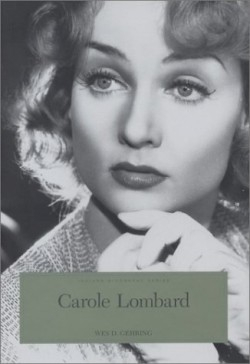Carole Lombard
The Hoosier Tornado
In 1930, Paramount Pictures’ marketing department mistakenly spelled Carol Lombard’s first name with an “e” in promoting the film Fast and Loose, then decided that it would be too costly to change the posters. Lombard, ever the free spirit, is said to have blurted out, “What the hell, let’s keep it with the ‘e’.”
This book chronicles her life, from her birth in Fort Wayne, Indiana, in 1908 (her real name was Jane Alice Peters and the book’s subtitle was her nickname in Hollywood), to her childhood in California, and then her slow climb to stardom in films. The author writes that in grammar school she would scream with rage if the boys refused to let her join them in their sports, and that in high school she was a track and field star.
From 1921 to 1942 Lombard made sixty-two movies and was nominated for an Oscar for the classic film My Man Godfrey (1936), which also starred William Powell. Other famous co-stars included Irene Rich, Paul Lucas, Cary Grant, Gary Cooper, George Raft, Charles Coburn, Charles Laughton, Randolph Scott, Jack Benny, and Clark Gable, whom she married in 1939. Gehring describes how the actress “changed her priorities” after meeting Gable in 1938, “putting a man ahead of her movie career.”
In the genre of “screwball comedy,” Gehring writes, “her every action is mesmerizing, and while she performed admirably in other types of films, her screwball personae defined the genre. None of the genre’s other leading ladies, from Irene Dunne to Jean Arthur, could match her skill at doing physical comedy.”
One of Lombard’s most famous film scenes was from Nothing Sacred. In it, she can be seen trading punches with her co-star, Fredric March. As a young tomboy, she had received boxing lessons from former lightweight champion Benny Leonard. This image of Lombard as a feisty fighter ultimately served as an apt metaphor for her gung-ho philosophy of life. She was fond of saying that her feature movie career started with “seventeen flops in a row.”
Her zany film legacy is central to how she is remembered, Gehring believes, because it is so closely identified with the real person. Even though fans often blur the distinction between performing and reality, “Lombard pushed the phenomenon to a higher level.”
Gehring tells how Lombard’s face was cut in an auto accident in 1925. For a time her budding film career seemed over, but plastic surgery, makeup, and camera tricks ultimately helped to minimize the scar. Gehring quotes the actress as saying, “Someday I’m going to catch the person who started all this glamour stuff about me and when I do, I’ll cuff him to death with his own typewriter.”
On January 6, 1942, after participating in a World War II war bond rally in Indianapolis, the actress was urged by her mother—who was deathly afraid of flying-to take a train back to California, but she decided to fly home. After refueling in Las Vegas, the plane, with Lombard, her mother, and twenty others aboard, crashed in the Spring Mountains. There were no survivors.
Gehring is the author of five other books dealing with films, including American Dark Comedy: Beyond Satire and Groucho and W.C. Fields: Huckster Comedians. Here, he offers plot synopses of Lombard’s many movies, and quotes from the major film critics of that era. He tells which films made money, which lost money, and why. The author has not only given us a fascinating look at the actress and her films, but-more importantly-has written an in-depth study of the private person, and placed it within the context of her time.
There have been many biographies of this famous actress, but what makes this one stand out is both the author’s huge amount of research and his obvious love of his subject. Drawing on a wealth of books, periodicals, manuscripts, interviews, and newspaper articles, Gehring has brought the slapstick legacy of Carole Lombard to a generation of readers too young to have watched her from a seat in the balcony.
Disclosure: This article is not an endorsement, but a review. The publisher of this book provided free copies of the book to have their book reviewed by a professional reviewer. No fee was paid by the publisher for this review. Foreword Reviews only recommends books that we love. Foreword Magazine, Inc. is disclosing this in accordance with the Federal Trade Commission’s 16 CFR, Part 255.

